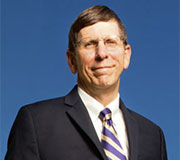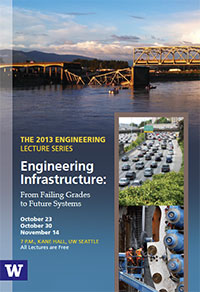In this issue:
- Dean's Message
- Research - Brain-to-Brain Interface; Energy from the Airwaves; Cochlear Implant Advance
- Campus News - Kientz a Top Innovator; Cleaner Cookstoves; Programming Language for DNA
- Events - Engineering Lecture Series; Northwest Institute for Advanced Computing
-
In the Media - Female Engineering Professors; Games to Master Math; Getting to Mars
Dean's MessageWith fall quarter in full swing, Dean Michael Bragg highlights some exciting research results, takes stock of UW Engineering's progress toward gender balance, and notes the college's participation in dialogue on the future of engineering in the United States. Read message » |

|
Research

|
Researcher controls colleague's motions in 1st human
brain-to-brain interface A UW team has successfully connected two human brains over the Internet. The scientists involved in the research were able to send a brain signal through the Internet to control the way another researcher, seated in a separate area of campus, moved his hand. The New York Times | CNN | USA Today | NPR Weekend Edition |
 |
Wireless devices go battery-free UW engineers have created a new wireless communication system that allows devices to interact with each other without relying on batteries or wires for power. The technique harvests energy from ubiquitous TV and cellular transmissions. Technology Review | Time | NBC News |

|
New strategy lets cochlear implant users hear music For users of cochlear implants—technology that allows deaf and hard of hearing people to comprehend speech—hearing music remains extremely challenging. A team of UW researchers has developed a new way of processing the signals in cochlear implants to let users perceive differences between musical instruments, a significant improvement from what standard cochlear implants can offer. KPLU | KOMO News | The Engineer |
Campus News
|
|
Julie Kientz named one of world's top innovators under 35 With her people-first perspective on technology, the HCDE assistant professor is at the forefront of an emerging idea: using relatively simple and common computing tools to improve human health. GeekWire | The Seattle Times | The (UW) Daily |
 |
UW engineers to make cookstoves 10 times
cleaner The goal: a high-efficiency, low-emissions cookstove that is affordable and attractive to families around the world who cook over a flame each day. UW mechanical engineers, with support from the U.S. Department of Energy, will pursue that by designing a stove for East African communities and creating software that helps other stove designers create efficient designs. |

|
UW engineers invent programming language to build synthetic
DNA An interdisciplinary team led by UW computer science and electrical engineering researchers has developed a programming language for chemistry that could ultimately guide the behavior of chemical-reaction mixtures in the same way that embedded electronic controllers guide cars, robots and other devices. CNET | Gizmodo | GeekWire | Fast Company |
Events

|
Engineering Infrastructure: From Failing Grades to Future Systems Attend the two remaining lectures in the College of Engineering's annual fall lecture series, presented in partnership with the UW Alumni Association. Spanning the Gap: Lessons in Bridge Engineering Wednesday, Oct. 30 7 p.m. Kane Hall John Stanton, Civil and Environmental Engineering Tunneling Toward a New State Route 99 Corridor Thursday, Nov. 14 7 p.m. Kane Hall Matthew Preedy, UW engineering alumnus and deputy program administrator for the state's Alaskan Way Viaduct Replacement Program Free registration is required. All of the lectures will air at a later date on UWTV. |
 NIAC Day: Learn about the Northwest Institute for Advanced Computing Wednesday, Oct. 30 9 a.m. - 5 p.m. HUB 145 NIAC is a new collaborative center for advanced computing at the intersection of science, academia and industry. At NIAC Day, speakers from UW, Pacific Northwest National Laboratory, and industry discuss NIAC research and the long-term vision for the institute. There will be several breakout sessions to choose from. Free; registration required. |
|
In the Media
 |
UW female professors building a culture for engineering The Seattle Times | Oct. 14, 2013 The UW has seen steady growth in the number of women in engineering and science faculty positions since it received a national grant to help boost the numbers. |
 |
Computer games + math = fun and learning in schools The Seattle Times | Aug. 21, 2013 The UW Center for Game Science got more than 4,000 Washington students to master linear equations this spring by playing a computer game for just a few hours. |

|
Quick fusion-powered trips to Mars no fantasy, scientists say CBS News | Oct. 8, 2013 Sending astronauts to Mars aboard a superfast spacecraft powered by nuclear fusion may seem like a sci-fi dream, but it's entirely attainable, UW scientists say. |